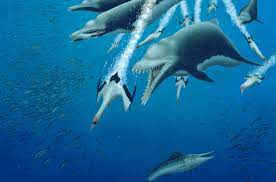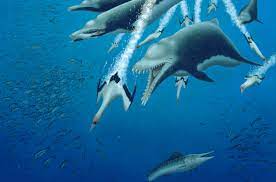
Killer Whale Adaptations.Killer Whale Adaptations is perfectly adapted to its aquatic life.We explain what an orca is, what its habitat is, its diet, reproduction and other characteristics.
Killer Whale Adaptations For Survival In Water.

Diving adaptations:
When a killer whale dives, it will slow down its heartbeat. By doing this, you will control the amount of blood circulating through your body. The blood will then be pushed to your heart, brain, and lungs instead of certain parts of your body that can tolerate a lower oxygen level. Muscles also have a lot of myoglobin. Myoglobin will store oxygen and help prevent oxygen depletion within the muscles. Orcas can dive up to 200 feet below water in their natural habitat.
Its color:
An orca’s coloration could improve its hunting ability. Both the female and male killer whales have an intense black and white color. Most of the killer whale’s body is shiny black, with a white belly and prominent white spots over its eyes. The whale’s black skin blends with the ocean’s dark coloration, so looking down from a position closer to the surface will make the whale harder to tell. Along the same lines, the white of its belly blends with the sky and it will be camouflaged with the sun that shines in the sea if you look at the whale from below.
Blubber:
Heat is always lost up to 27 times faster in water than in air. A whale has a thick layer of blubber under its skin called blubber. This fat maintains a constant body temperature. The blubber will also act as the whale’s energy reserve.
Jaw Muscles and Teeth:
A whale has a large, powerful jaw that is lined with up to 50 spike-shaped teeth that are adapted to rip and tear prey. A whale will not chew on these teeth.
Hairless
A whale has a smooth body and is hairless. If a whale had hair, this would create turbulence. This would prevent them from swimming so fast.
Orcas, in general, are characterized by the following:
- They are marine mammals, adapted to submerged life, with a characteristic black and white body , endowed with hydrodynamic proportions.
- The males of the species can measure up to 9 meters long and weigh 5.5 tons, while the females range around 7.7 meters long and 4 tons in weight. Both sexes have an extensive dorsal fin that can reach 1.8 meters in length.
- It is a natural born marine super predator , without rivals or natural enemies, that uses echolocation (emitting sound underwater) to perceive its prey.
- They are migratory animals , which make up more or less extensive herds, capable of coordinating an attack on larger prey, such as whales or white sharks.
- Four different types of killer whales have been identified , whose physical distinctions are more or less obvious, and which could indicate that new species have formed over time. It is a species under intense study by marine biologists.
- They are highly intelligent animals , among the few capable of recognizing themselves in a mirror. They are capable of playing, of imitating other animals and of transmitting teachings to their offspring.
Leave a Reply